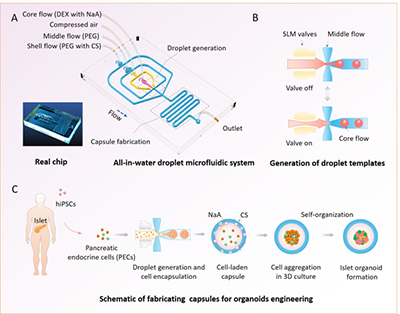Organoids are multicellular tissues formed by self-organization of stem cells in 3D culture, representing a new class of organ models that mimic corresponding native organs.
Generally, organoid derivation protocols mainly rely on self-organization of stem cells in 3D animal-derived matrices by tedious operations. However, organoids are often limited by significant variability and low throughput.
Advances in hydrogels have offered opportunities to recreate 3D tissue/organ models with more physiological relevance in a controlled manner. In addition, droplet microfluidic has attracted much attention in building cellular spheroids due to its inherent advantages of high-throughput and controllability.
Schematic diagram of all-in-water droplet microfluidic system to fabricate hybrid hydrogel capsules that enable 3D culture and generation of islet organoids (Image by DICP)
In this study, the researchers presented a novel strategy for one-step and high-throughput fabrication of hydrogel capsules in a droplet microfluidic system that enables stem cell organoids engineering by combining bioengineering technology, materials and stem cell biology.
The proposed capsules allowed for 3D culture, growth, and massive generation of human islet organoids from human induced pluripotent stem cells (hiPSCs) in a continuous process.
The researchers designed a microfluidic chip with pneumatic valves and manipulated for the generation of water-in-water droplets that were utilized as templates for fabrication of binary capsules relying on interfacial complexation of oppositely charged Na-alginate (NaA) and chitosan (CS).
The islet organoids generated within the capsules exhibited great uniformity on their size and morphology due to the controllable generation progress. Also, these organoids displayed cellular viability and sensitive glucose-stimulated insulin secretion function.
The proposed strategy can not only facilitate the reproducibility of organoids by providing uniform and defined 3D scaffolds, but also produce organoids massively.
This system is scalable, easy-to-operate and stable, which could offer a robust platform for various stem cell organoids engineering and advancing their biomedical applications.
This research was supported by the Strategic Priority Research Program of the Chinese Academy of Sciences and National Nature Science Foundation of China.





